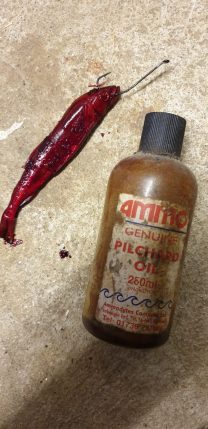Pike Tricks For Bass by Richard Brandon
I’m sure you’ll recall advice from ancient angling books, or mates, along the lines of “your old pike rod will do” or “use a stout spinning rod, one you’d use for pike”. Sometimes they were right, and you could trundle down to the coast or estuary and make do at certain marks for tackling bass.
But what about the other end? Less has been suggested about the potential crossover between pike techniques and methods for bass.
Over the past few seasons, I have been tentatively experimenting with some of these, fully aware that they are two very different predators, and that we may have to be cautious in making assumptions. However, there is sufficient commonality between them to consider the viability of trying things out in the salt. The patch I fish is primarily rocky ground and quiet estuaries, so the following applies to these situations.
 In relatively calmer water, estuaries, gullies etc., deadbaits such as mackerel, smelt, sprat and the like can be employed with subtle rod movements to incite bass to hit wounded prey. A slow sink-and-draw retrieve typifies this wobbled deadbait method. These baits have enough weight in them to be cast the often short distances close alongside rocks and other structures. To prolong the use of the partially-thawed deadbait, lip hook it and slip a 5mm. square of red elastic band over the single hook well past the barb. Like lures, the take can often be gentle as well as savage.
In relatively calmer water, estuaries, gullies etc., deadbaits such as mackerel, smelt, sprat and the like can be employed with subtle rod movements to incite bass to hit wounded prey. A slow sink-and-draw retrieve typifies this wobbled deadbait method. These baits have enough weight in them to be cast the often short distances close alongside rocks and other structures. To prolong the use of the partially-thawed deadbait, lip hook it and slip a 5mm. square of red elastic band over the single hook well past the barb. Like lures, the take can often be gentle as well as savage.
By just unclipping the lead, you can quickly change from a legered rig and deploy a wobbled one, though you may prefer to freeline. Particularly useful if you come across a hunted shoal of preyfish and you’re not getting takes on static bait.
Vaned floats were the norm on larger inland pike waters, and transfer readily to bassing, especially where you want to present an off-bottom bait over graunchy ground. You can, by using the wind and rod tip held high, send the float searching hard-to-reach areas as well as at distance. By cutting a slot in a pencil float, you can glue a vane into it. Thin fruit box wood or balsa, some painted red, some black, in various sizes from 7cm. square upwards for different lights, works well, and to aid line control and striking, you can rub on line floatant with a cloth. The vane reduces eyestrain too!
Again, in calm conditions, to increase scent trails when piking we used to pour (or use a big bore syringe) as much pilchard oil as we could down the throat of bottom-fished deadbaits before lobbing out. It made a significant difference to takes, and may have some potential application to close-in bassing?
Curiosity used to catch some wary pike, and coloured sprats, mackerel and smelt, well-daubed with cheap red food dye (to imitate wounded prey), used to be effective. The safe dye will stay on a good half hour before needing a “respray”; beware though, it gets everywhere! I remember paying at a toll bridge, and the operator’s shocked face as she noticed my hand and wrist covered in “blood”, as I passes her the coins!
For maximising scent in ground relatively crab-free or in coloured water, you can swap your paternoster lead for a weighted swimfeeder crammed with mashed fish and pilchard oil. I say crab-free areas. Imagine one getting it and marching off delighted with the feeder, like pushing a supermarket trolley!
For others with a coarse fishing background, I’m sure there are numerous other nuances adaptable for bass fishing, hopefully this may prompt you to try them when other presentations in tricky conditions aren’t working?
First published in Sea Angler in 2020